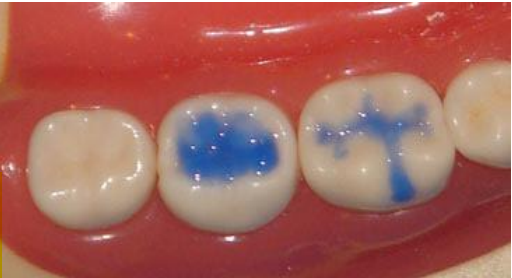
When it comes to restorative dentistry, one essential process you might encounter is teeth etching. This technique is a crucial step in ensuring the strong, durable bond of dental materials to your natural tooth structure. Here’s an in-depth overview to help you understand what teeth etching is, why it’s important, and how it’s done.
What is Etching?
Teeth etching involves treating the enamel (or dentin) surface of your tooth with an acidic substance (usually a blue gel) to prepare it for bonding with dental materials like composite resin fillings. The process primarily relies on micromechanical bonding, aka creating a roughened surface that dental adhesives can grip onto more effectively.
Etching enamel usually removes approximately 10 microns of enamel and creates a porous (hole-filled) layer into which the filling materials can penetrate. This layer, which is about 5-50 microns deep, is crucial for forming a strong bond that will last your entire lifetime.
Typically acid etching is used during the following procedures:
- Fissure Sealants: Occlusal (biting) surfaces of teeth have grooves or fissures that are vulnerable to cavities. Etching these surfaces allows the dentist to then apply a strong sealant to prevent decay.
- Dental Filling Materials: Etching increases the surface area to which filling materials bond, allowing for strong attachment to composite resin fillings. Note: Acid etching is not used for glass ionomer fillings and amalgam fillings.
- Enamel Hypoplasia Treatment: For conditions like enamel hypoplasia, etching helps in achieving better adhesion of restorative materials.
Types of Etching
There are primarily two types of etching techniques used in dentistry: regular etching (total-etch) and self-etching.
Regular Etching (Total-Etch):

- 37% Phosphoric Acid: This is the most commonly used etching agent in dental practices.
- Selective Dissolution: The acid selectively dissolves hydroxyapatite.
- Surface Debris Removal: The acid removes any surface debris, ensuring a clean bonding area.
- Antibacterial Action: The etching process also has some antibacterial benefits, helping to clean the tooth surface.
Self-Etching:

- Etchant-Adhesive Combination: This method uses an etchant combined with an adhesive in a single application, simplifying the process.
- Milder Etching Action: The self-etching technique is less aggressive than total-etch, which can be gentler on the dentin.
- Fewer Steps: Since the etchant and adhesive are applied together, it reduces the number of steps and time required for the procedure.
- Less Sensitivity: This technique is often associated with reduced post-operative sensitivity.
What to Expect During Teeth Etching
Preparation of the Tooth:

Your dentist will clean your tooth using a special polishing brush or cup with pumice. Other methods, such as a bur, air abrasion, or explorer, can also be used to help remove debris. The tooth is then rinsed thoroughly to remove any cleaning materials.
Isolate the Tooth/Teeth:

Next, a dentist will use one of the following methods to isolate the teeth they are working on: Rubber dams, cotton rolls, and or suction. This helps keep the area dry and free from moisture. Contaminants such as saliva, blood, or debris can significantly reduce the strength of the tooth structure underneath.
Dry the Tooth:

The tooth is carefully dried to prepare for etching.
Apply Acid Etch:

The acid is applied to the tooth using a small brush or tip. It is placed only on the areas that need to be etched, aka wherever filling material will be placed later. Dentists will then wait a specific amount of time (typically between 10-60 seconds) for the acid to etch your enamel. Too short and not enough etching will be done. Too long and the tooth structure underneath will collapse.
Rinse the Tooth/Teeth:

The tooth is rinsed anywhere between 5-20 seconds to remove the etchant.
Checking That the Tooth is Etched

The tooth should look chalky or frosty white. This look is similar to what the beginning of a cavity might look like, also known as an incipient lesion. Fun fact, these cavities can be reversed! If it doesn’t look chalky or white, the dentist will re-etch it for another 10 seconds.
Conclusion
Teeth etching is a vital step in restorative dental procedures, ensuring the effective bonding of dental materials to your teeth. Understanding this process and its importance can help you appreciate the care and precision your dentist employs to ensure the best possible outcomes for your dental health. Always follow your dentist’s advice and take precautions to maintain the integrity of the etched surface for optimal results. With proper technique and care, etching can provide strong, durable, and reliable bonds for various dental restorations, contributing to your overall oral health.
Disclaimer
The contents of this website, such as text, graphics, images, and other material are for informational purposes only and are not intended to be substituted for professional medical advice, diagnosis, or treatment. Nothing on this website constitutes the practice of medicine, law or any other regulated profession.
No two mouths are the same, and each oral situation is unique. As such, it isn’t possible to give comprehensive advice or diagnose oral conditions based on articles alone. The best way to ensure you’re getting the best dental care possible is to visit a dentist in person for an examination and consultation.
SAVE TIME AND MONEY AT ANY DENTIST

Less dental work is healthier for you. Learn what you can do to minimize the cost of dental procedures and avoid the dentist altogether!

